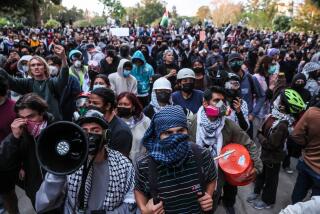Critics Find Irvine Rather Less Than Ideal as a Model City
- Share via
IRVINE — In a city never shy about indulging in a measured dose of self-congratulation, a community forum Sunday at the Irvine Fine Arts Center offered its share of surprises.
“I always feel alone here,” Alan Jacobs, a professor of city and regional planning at UC Berkeley, told an audience of about 50 Irvine residents and others. “It’s a very strange feeling to be in a hotel and know that there’s no place you can walk.”
Raymond Watson, vice chairman of the Irvine Co., winced at Jacobs’ remarks, as did many members of the audience, who had come to hear a panel discuss “Irvine: Model City? Model Society?” A brochure advertising the event noted that panelists would elaborate on “how Irvine has met the challenge of creating and maintaining its own model community.”
But Jacobs plunged on, describing Irvine as a city that emphasizes insularity, isolation, homogeneity and separateness, a place that’s comfortable for people who want mostly to be left alone and one where “if you don’t have a car, you’re dead.”
“Maybe that’s why I . . . feel claustrophobic here,” Jacobs added.
Sanjoy Mazumdar, a professor of social ecology at UC Irvine, broached some of the same concerns, albeit less bluntly. Mazumdar urged Irvine planners to strive to create a cultural and physical center, a place where people could interact more easily than on broad streets of fast-moving traffic.
Those remarks, along with one resident’s angry complaint that Irvine has turned its back on homosexuals, combined to turn the event into a lively forum for community self-examination.
By the session’s end, it appeared that participants found precious little to agree on about Irvine, short of the fact that if it is indeed a “model city,” its model offers a mixed set of lessons for those choosing to follow it.
“Models are supposed to provide a guide for future action, and I think Irvine does that,” Mayor Larry Agran said. “There are many successful aspects of city planning to learn from. There are also some negative aspects, the most significant of which is the intrusion of the private automobile.”
Defending Irvine’s guiding plan, Watson still found fault with the city’s current guardians, accusing city officials of acting as a divisive rather than a unifying force in Irvine, and chastising “slow-growth and no-growth” advocates for making it harder for the city to deal with its housing and transportation woes. Watson did not name the city officials he had in mind, but Agran, one of the state’s best-known slow-growth proponents, arched an eyebrow from his seat in the second row.
Still, Watson, who stressed that he was speaking for himself and not for the entire Irvine Co., touted Irvine’s strengths as a model for other cities.
“I’m very proud of what happened here,” Watson said. “That doesn’t mean it’s perfect.”
To Jacobs, Irvine’s weaknesses suggested a solution as simple in principle as it is ambitious in practice: to convert the Irvine Business Complex, a 2,500-acre area near John Wayne Airport, into a teeming pedestrian area replete with the amenities and opportunities that distinguish great cities.
“That’s as good an area as any,” Jacobs said. Diversity and cultural interaction will gravitate around an urban core, he added, and the complex offers a chance to create such a center in Irvine.
Despite the criticisms voiced by some panelists, residents who came to Sunday’s event were cautious about making any drastic changes in the way their community looks or operates.
“I’d have to look at what it was,” 21-year Irvine resident Lee Sicoli said of Jacobs’ proposal for a new urban center.
Carol Ennis, who moved to Irvine four years ago from Indiana, also cautioned against moving too quickly to transform the city. “These things take time,” she said.
More to Read
The biggest entertainment stories
Get our big stories about Hollywood, film, television, music, arts, culture and more right in your inbox as soon as they publish.
You may occasionally receive promotional content from the Los Angeles Times.











